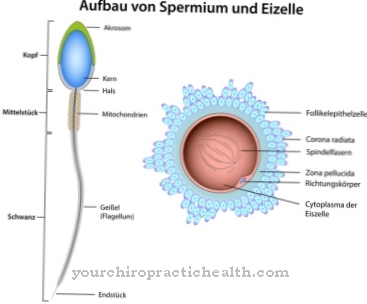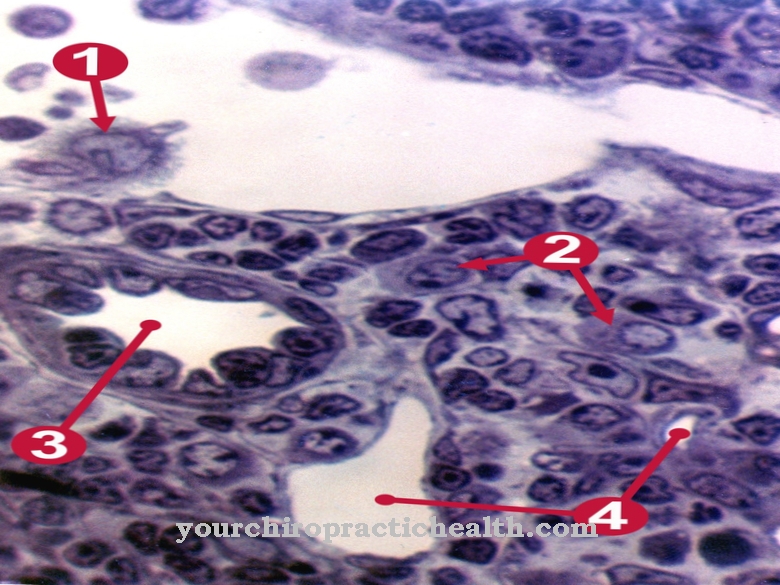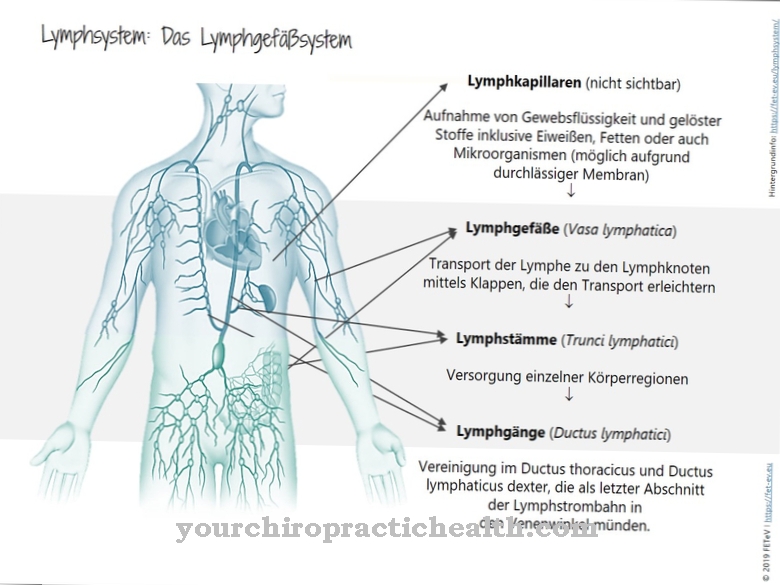The paired Facial artery originates as the third main branch of the external carotid artery (arteria carotis externa) and supplies large parts of the surface structures of the face including the nose, lips and tongue. The Facial artery takes a conspicuously winding course and shows several branches in order to be able to supply the entire area with oxygen-rich blood from the pulmonary circulation.
What is the Facial Artery?
The facial artery, also called the facial artery or Facial artery named, rises as the third main branch of the outer carotid artery and shows a multiple winding course with several branches in the face and neck area in order to be able to supply almost the entire surface area of the face and part of the neck as well as the tonsils with oxygenated blood.
The facial artery ends at the inner corner of the eye in the form of the angular artery. In terms of the structure of its vascular wall, the facial artery is one of the transitional forms from the elastic to the muscular type. This means that it plays a role both in smoothing arterial blood flow and in regulating systolic blood pressure through stress hormones that the sympathetic nervous system can release. The smooth muscles in the walls of the artery react to the hormones by contracting, so that the blood vessel becomes narrowed and the blood pressure rises.
Anatomy & structure
The facial artery, which arises from the external carotid artery at the level of the lower jaw, runs a short distance along the lower side of the lower jaw and then swings upwards and pulls sideways from the nose to the inner corner of the eye, where it ends as the angular artery and joins the capillary system.
The ascending palatal artery (arteria palatina ascendens), the lower chin artery (arteria submentalis), the lower and upper lip arteries (arteria labialis superior / inferior) and the terminal branch, the angular artery (angular artery) branch off from the facial artery. It is noticeable that a side branch of the facial artery anastomoses with a branch of the higher maxillary artery. This means that there is a direct connection between two arterial branches, so that if one of the two arteries fails, the other vessel can act as a backup.
The facial artery corresponds to the mixed artery type, the transition form from the large, elastic artery close to the heart like the aorta to the muscular type. This means that their middle vessel wall, the tunica media or media, contains elastic fibers as well as ring-shaped and helically sloping smooth muscle cells. While the elastic fibers react passively to an increase in blood pressure by stretching and enlarging the lumen of the vessel, the smooth muscle cells respond to stress hormones. They cause the muscle cells to contract so that the vessel becomes narrowed and the blood pressure rises accordingly.
Function & tasks
One of the main functions and tasks of the facial artery is to supply the surface structures of the face with oxygenated blood. The facial artery fulfills this function and task via its branching vessels. In detail, the ascending palatal artery supplies the pharynx and the submental artery supplies the mandibular salivary glands and the adjacent structures.
The inferior and superior labial arteries supply the lower and upper lip and the terminal branch, the angular artery, is aimed at supplying the nose and the structures in the inner corner of the eye. As a mixed type, the facial artery embodies the transition from a large, elastic artery close to the heart to the muscular type. This means that the facial artery makes a small contribution to the passive Windkessel function of the elastic vessels, but also plays a part in the active narrowing or widening of the lumen due to the smooth muscle cells in its middle vessel wall, the media.
During ventricular systole, the Windkessel function smooths the blood pressure peak by expanding the vascular lumen and stabilizes the blood flow. During diastole, the relaxation phase of the chambers, the vessel walls contract again and thus maintain the necessary residual pressure (diastolic pressure). The smooth muscle cells contained in the media are also able to respond to stress hormones by contraction. This leads to a constriction of the vessels with the effect of increasing blood pressure.
The mechanism in which the facial artery is involved is important in stressful situations and with changing performance requirements due to physical or mental exertion.
Diseases
Possible diseases and complaints that can affect the facial artery are the same as those that are known to affect other arteries. The most common problems arise from a narrowing (stenosis) of the lumen of the facial artery.
This leads to an insufficient supply of the subordinate supply areas. The only exception here is the terminal branch of the facial artery, which is directly connected to the inferior alveolar artery, a side branch of the maxillary artery, so that if the facial artery fails partially, the inferior alveolar artery can take over the supply “from the other side”. Stenoses are usually caused by arteriosclerosis, in which deposits, so-called plaques, form in the media, sclerotise the vessel at the point and protrude into the lumen, causing the narrowing.
Bottlenecks can also form in the vessels as a result of local inflammation, for example as an effect of an immune response to an infection. In some cases, blood clots (thrombi) can form at the source of inflammation, which lead to a thrombosis, a blockage of the vessel. In rare cases, thrombi can be carried along with the bloodstream and lodge in a smaller artery and cause an embolism, with sometimes far-reaching consequences.
Bulging, so-called aneurysms, are extremely rare and relatively easy to identify in the area of the facial artery, because the vascular network of the facial artery is usually located on the surface of the face and possible bleeding is usually easily accessible.
























.jpg)



